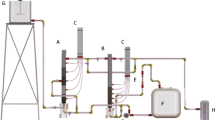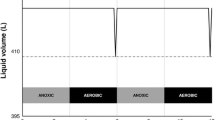Abstract
The aim of the study was to evaluate the oxidation of sulfides using nitrate as an electron acceptor in an anaerobic hybrid reactor (AHR) connected to an intermittent flow sand filter (IFSF) for post-treatment. The study was carried out in four phases in which the AHR was fed with 100% raw sewage (phase I) followed by phases II, III and IV involving different proportions of raw sewage and recycled nitrified IFSF effluent (83:17, 67:33 and 50:50, respectively). The results showed that 41% of the oxidized forms of sulfur were accumulated in the anaerobic phase with 31% in the form of sulfate and 10% as elemental sulfur. Increased proportions of nitrified IFSF effluent into the AHR favored denitrification and afforded up to 38% removal of nitrogen during the anaerobic stage and 46% in the final effluent. The removal efficiency of total dissolved sulfide by the system was up to 99.3% in phase IV, the influent of which contained the highest proportion of nitrified effluent. It is concluded that the combination of AHR and IFSF offers excellent conditions for the removal of chemical oxygen demand, nitrogen and sulfides from sanitary sewage using nitrate as an electron acceptor. Furthermore, the proposed treatment system represents a low-cost and energy-saving approach that addresses the anaerobic digestion of biosolids as well as the control of malodorous gas formation.




Similar content being viewed by others
Data Availability
Not applicable.
References
American Public Health Association (2012) Standard methods for the examination of water and wastewater, 22nd edn. APHA, AWWA, WPCF, Washington
Associação Brasileira de Normas Técnicas (1995) Rochas e solos, NBR 6502. ABNT, Rio de Janeiro. http://licenciadorambiental.com.br/wp-content/uploads/2015/01/NBR-6.502-Rochas-e-Solos.pdf (Accessed on December 1, 2018)
Auguet O, Pijuan M, Borrego CM, Gutierrez O (2016) Control of sulfide and methane production in anaerobic sewer systems by means of downstream nitrite dosage. Sci Total Environ 550:1116–1125. https://doi.org/10.1016/j.scitotenv.2016.01.130
Barbosa RA (2017) Remoção de sulfetos e obtenção de enxofre elementar em reatores UASB com adição de oxidantes. Universidade Estadual da Paraíba. Campina Grande, MSc Dissertation
Barbosa RA, Sousa JT, Lopes WS, Leite VD, Cabral LLB (2019) Remoção de sulfetos em reatores UASB microaerados tratando esgoto sanitário. Rev DAE 216:5-19 [article in Portuguese]. https://doi.org/10.4322/dae.2019.011
Beristain-Cardoso R, Texier A-C, Sierra-Álvarez R, Field JA, Razo-Flores E, Gómez J (2008) Simultaneous sulfide and acetate oxidation under denitrifying conditions using an inverse fluidized bed reactor. J Chem Technol Biotechnol 83:1197–1203. https://doi.org/10.1002/jctb.1921
Bisogni JJ, Driscoll CT (1977) Denitrification using thiosulfate and sulfide. J Environ Eng 103:593–604
Bitton G (2005) Wastewater microbiology, 3rd edn. Wiley, Hoboken
Chen C, Liu L, Lee D-J, Guo W, Wang A, Xu X, Zhou X, Wu D, Ren N (2014) Integrated simultaneous desulfurization and denitrification (ISDD) process at various COD/sulfate ratios. Bioresour Technol 155:161–169. https://doi.org/10.1016/j.biortech.2013.12.067
Chen J, Hanke A, Tegetmeyer HE, Kattelmann I, Sharma R, Hamann E, Hargesheimer T, Kraft B, Lenk S, Geelhoed JS, Hettich RL, Strous M (2017) Impacts of chemical gradients on microbial community structure. ISME J 11:920–931. https://doi.org/10.1038/ismej.2016.175
Cirne DG, van der Zee FP, Fernandez-Polanco M, Fernandez-Polanco F (2008) Control of sulphide during anaerobic treatment of S-containing wastewaters by adding limited amounts of oxygen or nitrate. Rev Environ Sci Biotechnol 7:93–105. https://doi.org/10.1007/s11157-008-9128-9
Correa CZ, Prates KVMC, Oliveira EF, Lopes DD, Barana AC (2018) Nitrification/denitrification of real municipal wastewater in an intermittently aerated structured bed reactor. J Water Process Eng 23:134–141. https://doi.org/10.1016/j.jwpe.2018.03.013
Foresti E, Zaiat M, Vallero M (2006) Anaerobic processes as the core technology for sustainable domestic wastewater treatment: consolidated applications, new trends, perspectives, and challenges. Rev Environ Sci Biotechnol 5:3–19. https://doi.org/10.1007/s11157-005-4630-9
Godoi LAG, Santos CED, Foresti E, Damianovic MHRZ (2017) Evaluating and refining alkalinity calculations due to sulfide and bicarbonate accessed by titration in anaerobic sulfate-reducing bioreactors. Water Air Soil Pollut 228:322. https://doi.org/10.1007/s11270-017-3518-y
Gusseme B, Schryver P, Cooman M, Verbeken K, Boeckx P, Verstraete W, Boon N (2009) Nitrate-reducing, sulfide-oxidizing bacteria as microbial oxidants for rapid biological sulfide removal. FEMS Microbiol Ecol 67:151–161. https://doi.org/10.1111/j.1574-6941.2008.00598.x
Huang C, Li Z-L, Chen F, Liu Q, ZhaoY-K GL-F, Chen C, Zhou J-Z, Wang A-J (2016) Efficient regulation of elemental sulfur recovery through optimizing working height of upflow anaerobic sludge blanket reactor during denitrifying sulfide removal process. Bioresour Technol 200:1019–1023. https://doi.org/10.1016/j.biortech.2015.09.109
Jorgensen BB, Kuenen JG, Cohen Y (1979) Microbial transformations of sulfur compounds in a stratified Lake (solar lake, Sinai). Limnol Oceanogr 24:799–822. https://doi.org/10.4319/lo.1979.24.5.0799
Krayzelova L, Bartacek J, Kolesarova N, Jenicek P (2014) Microaeration for hydrogen sulfide removal in UASB reactor. Bioresour Technol 172:297–302. https://doi.org/10.1016/j.biortech.2014.09.056
Lampe DG, Zhang TC (1996) Evaluation of sulfur-based autotrophic denitrification. U.S. Department of Energy, Office of Scientific and Technical Information. https://engg.ksu.edu/HSRC/96Proceed/lampe.pdf (Accessed on December 1, 2018)
Mainardis M, Buttazzoni M, Goi D (2020) Up-flow anaerobic sludge blanket (UASB) technology for energy recovery: a review on state-of-the-art and recent technological advances. Bioengineering 7:43. https://doi.org/10.3390/bioengineering7020043
Moraes BS, Souza TSO, Foresti E (2012) Effect of sulfide concentration on autotrophic denitrification from nitrate and nitrite in vertical fixed-bed reactors. Process Biochem 47:1395–1401. https://doi.org/10.1016/j.procbio.2012.05.008
Percheron G, Michaud S, Bernet N, Moletta R (1998) Nitrate and nitrite reduction of a sulphide-rich environment. J Chem Technol Biotechnol 73:213–220. https://doi.org/10.1002/(SICI)1097-4660(199807)72:3<213::AID-JCTB901>3.0.CO;2-5
Reyes-Avila J, Razo-Flores E, Gomez J (2004) Simultaneous biological removal of nitrogen, carbon and sulfur by denitrification. Water Res 38:3313–3321. https://doi.org/10.1016/j.watres.2004.04.035
Sabbah I, Ghattas B, Hayeek A, Omari J, Haj Y, Admon S, Green M (2004) Intermittent sand filtration for wastewater treatment in rural areas of the Middle East - a pilot study. Water Sci Technol 48:147–152. https://doi.org/10.2166/wst.2004.0827
Saia FT, Souza TSO, Duarte RTD, Pozzi E, Fonseca D, Foresti E (2016) Microbial community in a pilot-scale bioreactor promoting anaerobic digestion and sulfur driven denitrification for domestic sewage treatment. Bioprocess Biosyst Eng 39:341–352. https://doi.org/10.1007/s00449-015-1520-6
Sehar S, Naz I (2016) Role of the biofilms in wastewater treatment. In: Dhanasekaran D, Thajuddin N (eds) Microbial biofilms - importance and applications. IntechOpen, London. https://doi.org/10.5772/63499
Sousa JT, Santos KD, Henrique IN, Brasil DP, Santos EC (2008) Anaerobic digestion and the denitrification in UASB reactor. J Urban Environ Eng 2:63–67. https://doi.org/10.4090/juee.2008.v2n2.063067
Sousa JT, Lima JF, Silva VC, Leite VD, Lopes WS (2017) Recovery of elemental Sulphur from anaerobic effluents through the biological oxidation of sulphides. Environ Technol 38:529–537. https://doi.org/10.1080/09593330.2016.1201148
Souza TSO, Foresti E (2013) Sulfide-oxidizing autotrophic denitrification: an evaluation for nitrogen removal from anaerobically pretreated domestic sewage. Appl Biochem Biotechnol 170:1094–1103. https://doi.org/10.1007/s12010-013-0261-8
Speece RE (2008) Anaerobic biotechnology and odor/corrosion control for municipalities and industries. Archae Press, Nashville
Tchobanoglous G, Burton FL, Stensel HD (2003) Metcalf & Eddy Inc. wastewater engineering: treatment and reuse, 4th edn. McGraw-Hill, New York, New York
von Sperling M (2015) Comparison of simple, small, full-scale sewage treatment systems in Brazil: UASB-maturation ponds-coarse filter; UASB-horizontal subsurface-flow wetland; vertical-flow wetland (first stage of French system). Water Sci Technol 71:329–337. https://doi.org/10.2166/wst.2014.496
Wang A-J, Du D-Z, Ren N-Q, van Groenestijn JW (2005) An innovative process of simultaneous desulfurization and denitrification by Thiobacillus denitrificans. J Environ Sci Health A 40:1939–1949. https://doi.org/10.1080/10934520500184590
Wang X, Zhang Y, Zhou J, Zhang T, Chen M (2015) Regeneration of elemental sulfur in a simultaneous sulfide and nitrate removal reactor under different dissolved oxygen conditions. Bioresour Technol 182:75–81. https://doi.org/10.1016/j.biortech.2015.01.123
Yang W, Zhao Q, Lu H, Ding Z, Meng L, Chen G-H (2016) Sulfide-driven autotrophic denitrification significantly reduces N2O emissions. Water Res 90:176–184. https://doi.org/10.1016/j.watres.2015.12.032
Zhang R-C, Chen C, Shao B, Wang W, Xu X-J, Zhou X, **ang Y-N, Zhao L, Lee D-J, Ren N-Q (2020) Heterotrophic sulfide-oxidizing nitrate-reducing bacteria enables the high performance of integrated autotrophic-heterotrophic denitrification (IAHD) process under high sulfide loading. Water Res 178:115848. https://doi.org/10.1016/j.watres.2020.115848
Zhu I, Getting T (2012) A review of nitrate reduction using inorganic materials. Environ Technol Rev 1:46–58. https://doi.org/10.1080/09593330.2012.706646
Funding
The study was funded by the Financiadora de Estudos e Projetos-FINEP and the Conselho Nacional de Desenvolvimento Científico e Tecnológico-CNPq.
Author information
Authors and Affiliations
Contributions
Conception and design of study: JTS, WSL, VDL; Supervision of work: JTS and WSL; Acquisition, analysis and interpretation of data: LLBC and WSL; Drafting of the manuscript: LLBC and WSL; Critical revision of the manuscript and final approval: LLBC, JTS, WSL, RAB and VDL.
Corresponding author
Ethics declarations
Conflicts of Interest/Competing Interests
The authors declare that there are no conflicts of interest.
Code Availability
Not applicable.
Additional information
Publisher’s Note
Springer Nature remains neutral with regard to jurisdictional claims in published maps and institutional affiliations.
Article Highlights
• The AHR-IFSF system increases sulfide removal to 99.3%, thus reducing the release of malodorous gases
• Increased proportions of nitrified effluent in the AHR favored denitrification with 46% N removal in the final effluent
• NO3− and NO2− are suitable electron acceptors and an N:S molar ratio of 0.73 is appropriate for sulfide oxidation.
Rights and permissions
About this article
Cite this article
Cabral, L.L.B., Sousa, J.T., Lopes, W.S. et al. Performance of Anaerobic Hybrid Reactor with Post-Treatment in Intermittent Flow Sand Filter: a Sulfide-Oxidizing Bioprocess for the Treatment of Sanitary Sewage Using Nitrate as Electron Acceptor. Environ. Process. 7, 1095–1109 (2020). https://doi.org/10.1007/s40710-020-00469-w
Received:
Accepted:
Published:
Issue Date:
DOI: https://doi.org/10.1007/s40710-020-00469-w




